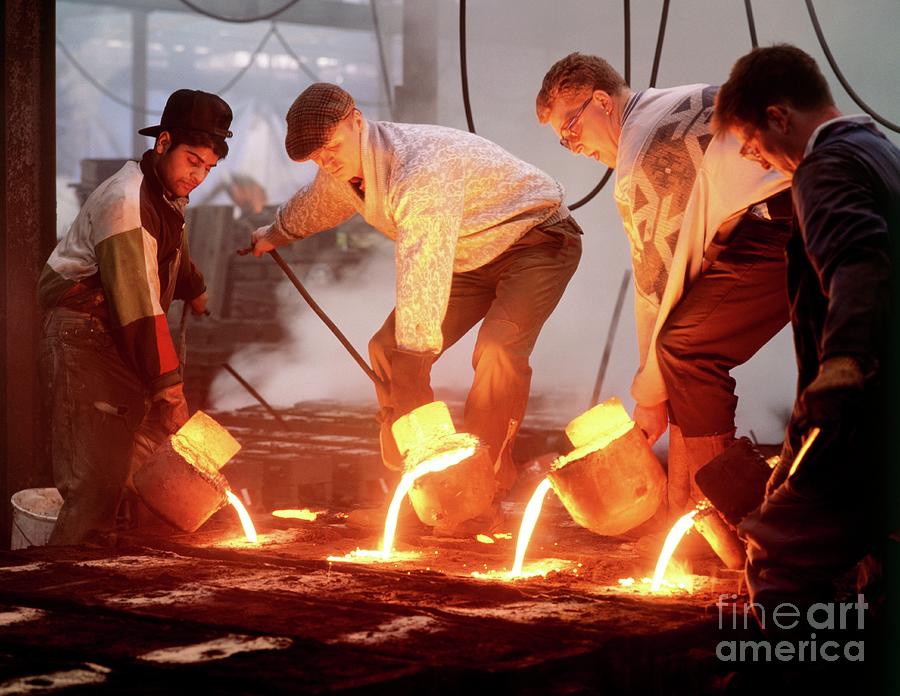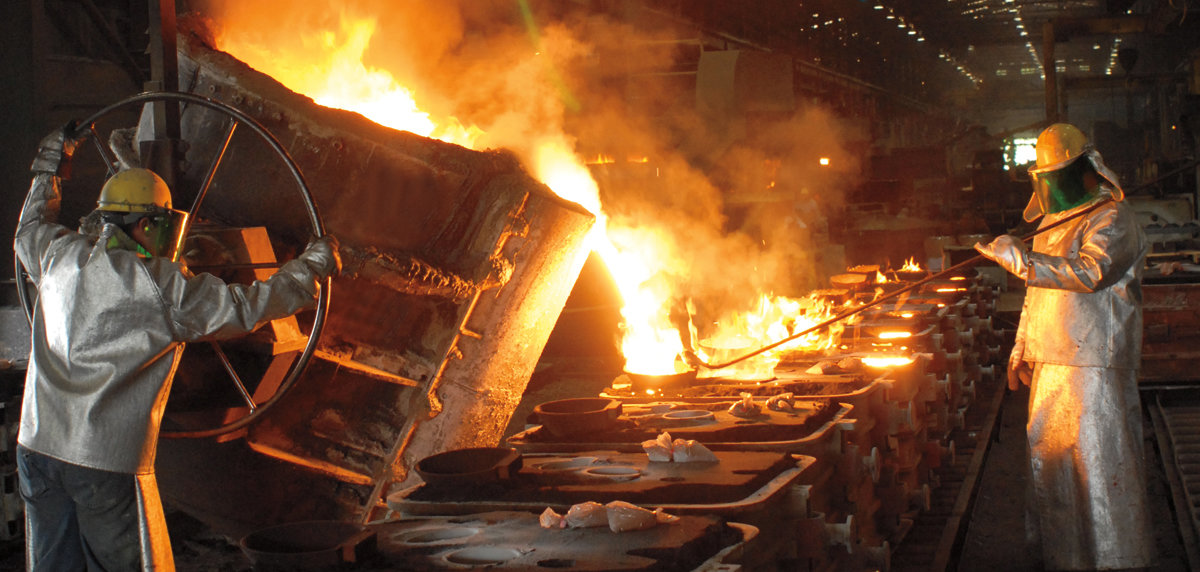Detailed overview of how an Aluminum Foundry melts, molds, and casts metal parts
Discover the Ingenious Methods Made Use Of in a Metal Foundry for Superior Casting Outcomes
In today's affordable production landscape, metal foundries are significantly embracing innovative strategies to improve spreading results - Metal Foundry. Advanced computer simulations enable for precise modeling of liquified metal behavior, while 3D printing makes it possible for fast production of complex mold and mildews. In addition, environmentally friendly products and automation simplify operations. These growths assure significant enhancements in efficiency and quality assurance. The effect of these modern technologies on sustainability and production practices stays to be completely discovered.
Advanced Computer System Simulations in Metal Casting
Advanced computer system simulations have actually reinvented the metal casting procedure by improving accuracy and effectiveness. These innovative tools allow engineers to create virtual models of cast components, allowing them to predict the actions and examine of molten metal throughout the spreading phase. By imitating numerous parameters such as temperature level, flow price, and cooling prices, makers can determine possible defects before physical production begins.
This positive method decreases waste and minimizes costly errors, inevitably bring about improved product high quality. Furthermore, simulations facilitate the optimization of mold styles, guaranteeing that they fulfill the certain needs of each task. The assimilation of computational fluid dynamics (CFD) and limited element evaluation (FEA) additional contributes to the precision of these simulations, supplying insights that were formerly unattainable. Therefore, advanced computer simulations have actually ended up being a vital element of contemporary metal foundries, substantially progressing the sector's capabilities.
3D Printing for Mold And Mildews and Patterns
3D printing has arised as a groundbreaking technique for developing molds and patterns in the metal foundry sector. This technology makes it possible for the rapid manufacturing of complex geometries that conventional production approaches have a hard time to attain. By using additive manufacturing, foundries can create elaborate designs with reduced lead times and product waste. The capacity to generate molds as needed permits better flexibility in style versions, promoting faster prototyping and alterations.
3D printing can utilize a variety of materials, consisting of plastics and metals, tailored to certain casting requirements. This versatility improves the precision of mold and mildews, resulting in exceptional spreading end results with boosted surface coatings. Furthermore, the reduction in the variety of parts required streamlines assembly procedures, additionally optimizing production performance. As foundries proceed to adopt 3D printing, they are poised to redefine market criteria, leading the way for innovation and enhanced efficiency in metal casting operations.
Eco-Friendly Materials and Processes
As the metal foundry industry faces enhancing pressure to decrease its environmental footprint, the fostering of eco-friendly materials and procedures has actually become essential. Factories are now exploring sustainable options to conventional materials, such as using recycled steels and bio-based binders. These products not just lessen waste however likewise lower power usage during production.
Additionally, innovations in sand spreading methods have actually brought about using artificial sands that are much less hazardous to the setting. Shops are likewise executing innovative procedures like liquified metal treatment that lowers discharges and enhances the top quality of actors products.
In addition, water-based finishes have changed harmful solvents, advertising a safer workplace (Metal Foundry). By incorporating these environment-friendly methods, metal foundries can substantially lower their environmental influence while maintaining high-grade casting results. This shift not just profits the setting yet also straightens with the expanding customer need for sustainable manufacturing options
Automation and Robotics in Foundry Procedures
While the metal foundry industry accepts technology, the integration of automation and robotics is changing operations significantly. Automated systems simplify processes such as mold making, metal putting, and casting ending up, significantly boosting efficiency. Robotics help with the handling of heavy products, lowering the danger of work environment injuries and making certain safer environments.

Even more, making use of automated guided lorries (AGVs) enhances material transport within centers, making sure prompt delivery of parts to suitable workstations. By executing these innovations, foundries can adjust to fluctuating demands with better dexterity, inevitably causing boosted earnings and competitiveness out there. As automation and robotics remain to progress, they hold the potential to redefine typical foundry methods and drive further innovations in casting methods.
Real-Time Tracking and Quality Assurance Techniques
The developments in automation and robotics have actually led the way for more advanced strategies to quality control in metal foundries. Real-time monitoring systems use innovative sensors and information analytics to track crucial parameters throughout the casting process. These systems continuously analyze variables such as material, temperature level, and stress composition, making it possible for prompt discovery of deviations from developed standards.
Quality control methods currently incorporate artificial intelligence formulas that evaluate historical data to forecast possible flaws before they take place. This proactive strategy decreases waste and improves total manufacturing performance. Additionally, incorporated comments loopholes enable quick changes, guaranteeing that each casting satisfies rigid top quality needs.
The execution of electronic doubles-- digital reproductions of physical properties-- has actually why not try these out additionally changed top quality guarantee, enabling engineers to replicate and maximize procedures in real-time. Together, these ingenious strategies significantly enhance the integrity and quality of castings, setting new market criteria in metal foundry operations.
Often Asked Concerns
What Types of Metals Are Typically Cast in Foundries?
Commonly cast metals in foundries consist of aluminum, iron, bronze, and brass. Each metal shows distinct properties, making them appropriate for different applications, such as automobile parts, machinery, and imaginative sculptures, boosting their adaptability in manufacturing.

For how long Does the Casting Process Commonly Take?
The spreading procedure typically takes numerous hours to days, depending on aspects such as the complexity of the mold, type of metal made use of, and cooling needs. Each phase influences the general period significantly.
What Precaution Are in Area for Foundry Workers?

Just how Are Flaws in Castings Identified and Addressed?
Problems in castings are recognized with visual inspections and non-destructive screening methods. When found, foundry More Bonuses employees address them by refining processes, adjusting material compositions, and applying restorative steps to guarantee quality and conformity with requirements.
What Is the Cost Variety for Metal Casting Solutions?
The price array for metal spreading solutions commonly varies in between $1 to $10 per extra pound, relying on elements such as product type, complexity of the design, and production quantity, impacting total prices considerably.
In today's affordable production landscape, metal foundries are increasingly adopting cutting-edge methods to improve spreading outcomes. As the metal foundry market deals with raising pressure to lower its environmental impact, the adoption of green products and procedures has come to be crucial. Shops are now exploring lasting options to traditional products, such as using bio-based binders and recycled metals. By incorporating these environment-friendly practices, metal foundries can noticeably lower their ecological impact while keeping top quality casting outcomes. The innovations in automation and robotics have paved the means for more advanced approaches to high quality guarantee in metal foundries.